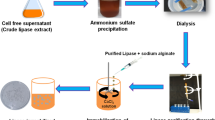Abstract
A total of 118 halophilic archaeal collection of strains were screened for lipolytic activity and 18 of them were found positive on Rhodamine agar plates. The selected five isolates were further characterized to determine their optimum esterase and lipase activities at various ranges of salt, temperature and pH. The esterase and lipase activities were determined by the hydrolysis of pNPB and pNPP, respectively. The maximum hydrolytic activities were found in the supernatants of the isolates grown at complex medium with 25% NaCl and 1% gum Arabic. The highest esterase activity was obtained at pH 8–8.5, temperature 60–65°C and NaCl 3–4.5 M. The same parameters for the highest lipase activities were found to be pH 8, temperature 45–65°C and NaCl 3.5–4 M. These results indicate the presence of salt-dependent and temperature-tolerant lipolytic enzymes from halophilic archaeal strains. Kinetic parameters were determined according to Lineweaver–Burk plot. The KM and V max values were lower for pNPP hydrolysis than those for pNPB hydrolysis. The results point that the isolates have higher esterase activity comparing to lipase activity.






Similar content being viewed by others
References
Bhatnagar T, Boutaiba S, Hacene H, Cayol JL, Fardeau ML, Olliver B, Baratti JC (2005) Lipolytic activity from halobacteria: screening and hydrolyses production. FEMS Microbiol Lett 248:133–140. doi:10.1016/j.femsle.2005.05.044
Boutaiba S, Bhatnagar T, Hacene H, Mitchell DA, Baratti JC (2006) Preliminary characterisation of a lipolytic activity from an extremely halophilic archaeaon, Natronococcus sp. J Mol Catal B Enzym 41:21–26. doi:10.1016/j.molcatb.2006.03.010
Chaga G, Porath J, Illeni T (1993) Isolation and purification of amyloglucosidase from Halobacterium sodomonse. Biomed Chromatogr 7:256–261. doi:10.1002/bmc.1130070504
Copeland RA (2000) Enzymes: a pratical introduction to structure, mechanism, and data analysis, 2nd edn. Wiley, New York
Corzo G, Revah S (1999) Production and characteristics of the lipase from Yarrowia lipolytica 681. Bioresour Technol 70:173–180. doi:10.1016/S0960-8524(99)00024-3
Dym O, Mevarech M, Sussman JL (1995) Structural features that stabilize halophilic malate dehydrogenase from archaebacterium. Science 267:1344–1346. doi:10.1126/science.267.5202.1344
Egorova K, Antranikian G (2005) Industry relevance of thermophilic archaea. Curr Opin Microbiol 8:1–7. doi:10.1016/j.mib.2004.12.015
Gandolfi R, Marinelli F, Lazzarini A, Molinari F (2000) Cell-bound and extracellular carboxylesterases from Streptomyces: hydrolytic and synthetic activities. J Appl Microbiol 89:870–875. doi:10.1046/j.1365-2672.2000.01194.x
Hough DW, Danson DJ (1999) Extremozymes. Curr Opin Chem Biol 3:39–46. doi:10.1016/S1367-5931(99)80008-8
Ikeda M, Clark DS (1998) Molecular cloning of extremely thermostable esterase gene from hyperthermophilic archaeon Pyrococcus furiosus in Escherichia coli. Biotechnol Bioeng 57:624–629 doi :10.1002/(SICI)1097-0290(19980305)57:5<624::AID-BIT15>3.0.CO;2-B
Izotova LS, Strongin AY, Chekulaeva LN, Sterkin VE, Ostoslavskaya VI, Lyublinskaya LA, Timokhina EA, Stepanov VM (1983) Purification and properties of serine protease from Halobacterium halobium. J Bacteriol 155:826–830
Kouker G, Jaeger KE (1987) Spesific and sensitive plate assay for bacterial lipase. Appl Environ Microbiol 53:211–213
Kordel M, Hofmann B, Schomburg D, Schmid RD (1991) Extracellular lipase of Pseudomonas sp. Strain ATCC 21808: purification, characterization, crystallization, and preliminary X-ray diffraction data. J Bacteriol 173:4836–4841
Margesin R, Schinner F (2001) Potential of halotolerant and halophilic microorganisms for biotechnology. Extremophiles 5:73–83. doi:10.1007/s007920100184
Martin S, Marquez MC, Sanchez-Porro C, Maellado E, Arahal DR, Ventosa A (2003) Marinobacter lipolyticus sp. nov., a novel moderate halophile with lipolytic activity. Int J Syst Evol Microbiol 53:1383–1387. doi:10.1099/ijs.0.02528-0
Matsumoto T, Ito M, Fukuda H, Kondo A (2004) Enantioselective transesterification using lipase-displaying yeast whole-cell biocatalyst. Appl Microbiol Biotechnol 64:481–485. doi:10.1007/s00253-003-1486-1
Oren A (2001) The order Halobacteriales. In: Dworkin M, Falkow S, Rosenberg E, Schleifer K-H, Stackebrandt E (eds) The prokaryotes. A handbook on the biology of bacteria: ecophysiology, isolation, identification, applications, 3rd edn. Springer, New York
Oren A (2002) Diversity of halophilic microorganisms: environments, phylogeny, physiology, and applications. J Ind Microbiol Biotechnol 28:56–63
Ozcan B, Cokmus C, Coleri A, Caliskan M (2006) Characterization of extremely halophilic archaea isolated from saline environment in different parts of Turkey. Microbiology 75:739–746. doi:10.1134/S002626170606018X
Ozcan B, Ozcengiz G, Coleri A, Cokmus C (2007) Diversity of halophilic archaea from six distinct parts of Turkey. J Microbiol Biotechnol 17:985–992
Panda T, Gowrishankar BS (2005) Production and applications of esterases. Appl Microbiol Biotechnol 67:160–169. doi:10.1007/s00253-004-1840-y
Perez-Pomares F, Bautista V, Ferrer J, Pire C, Marhuenda-Egea FC, Bonete MJ (2003) α-Amylase activity from the halophilic archaeon Haloferax mediterranei. Extremophiles 7:299–306. doi:10.1007/s00792-003-0327-6
Rodriguez-Valera F (1992) Biotechnol potential of halobacteria. Biochem Soc Symp 58:135–147
Rothschild LJ, Mancinelli RL (2001) Life in extreme environments. Nature 409:1092–1101. doi:10.1038/35059215
Ryu K, Kim J, Dordick JS (1994) Catalytic properties and potential of an extracellular protease from an extreme halophile. Enzyme Microb Technol 16:266–275. doi:10.1016/0141-0229(94)90165-1
Sanchez-Porro C, Martin S, Mellado E, Ventosa A (2003) Diversity of moderately halophilic bacteria producing extracellular hydrolytic enzymes. J Appl Microbiol 94:295–300. doi:10.1046/j.1365-2672.2003.01834.x
Tamerler CB, Martinez AT, Keshavarz T (2001) Production of lipolytic enzymes in batch cultures of Ophiostoma piceae. J Chem Technol Biotechnol 76:991–996. doi:10.1002/jctb.473
Teo JWP, Zhang LH, Poh CL (2003) Cloning and characterization of a novel lipase from Vibrio harveyi strain AP6. Gene 312:181–188. doi:10.1016/S0378-1119(03)00615-2
Vargas VA, Delgado OD, Hatti-Kaul R, Mattiosson B (2004) Lipase-producing microorganisms from a Kenyan alkaline soda lake. Biotechnol Lett 26:81–86. doi:10.1023/B:BILE.0000012898.50608.12
Ventosa A, Nieto JJ (1995) Biotechnological applications and potentialities of halophilic microorganisms. World J Microbiol Biotechnol 11:85–94. doi:10.1007/BF00339138
Waino M, Ingvorsen K (2003) Production of b-xylanase and b-xylosidase by the extremelyhalophilic archaeon Halorhabdus utahensis. Extremophiles 7:87–93
Acknowledgments
This study was supported by the Research Project Units of Mustafa Kemal University (project number 06 F 302) and in part by the Scientific and Technical Research Council of Turkey (TUBITAK) (project numbers 105T041 and 107T919).
Author information
Authors and Affiliations
Corresponding author
Rights and permissions
About this article
Cite this article
Ozcan, B., Ozyilmaz, G., Cokmus, C. et al. Characterization of extracellular esterase and lipase activities from five halophilic archaeal strains. J Ind Microbiol Biotechnol 36, 105–110 (2009). https://doi.org/10.1007/s10295-008-0477-8
Received:
Accepted:
Published:
Issue Date:
DOI: https://doi.org/10.1007/s10295-008-0477-8




